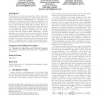Free Online Productivity Tools
i2Speak
i2Symbol
i2OCR
iTex2Img
iWeb2Print
iWeb2Shot
i2Type
iPdf2Split
iPdf2Merge
i2Bopomofo
i2Arabic
i2Style
i2Image
i2PDF
iLatex2Rtf
Sci2ools
90
Voted
ISSAC
2009
Springer
2009
Springer
H-LLL: using householder inside LLL
We describe a new LLL-type algorithm, H-LLL, that relies on Householder transformations to approximate the underlying Gram-Schmidt orthogonalizations. The latter computations are performed with floating-point arithmetic. We prove that a precision essentially equal to the dimension suffices to ensure that the output basis is reduced. H-LLL resembles the L2 algorithm of Nguyen and Stehl´e that relies on a floating-point Cholesky algorithm. However, replacing Cholesky’s algorithm by Householder’s is not benign, as their numerical behaviors differ significantly. Broadly speaking, our correctness proof is more involved, whereas our complexity analysis is more direct. Thanks to the new orthogonalization strategy, H-LLL is the first LLL-type algorithm that admits a natural vectorial description, which leads to a complexity upper bound that is proportional to the progress performed on the basis (for fixed dimensions). Categories and Subject Descriptors F.2.1 [Analysis of Algorithm...
| Added | 26 May 2010 |
| Updated | 26 May 2010 |
| Type | Conference |
| Year | 2009 |
| Where | ISSAC |
| Authors | Ivan Morel, Damien Stehlé, Gilles Villard |
Comments (0)

